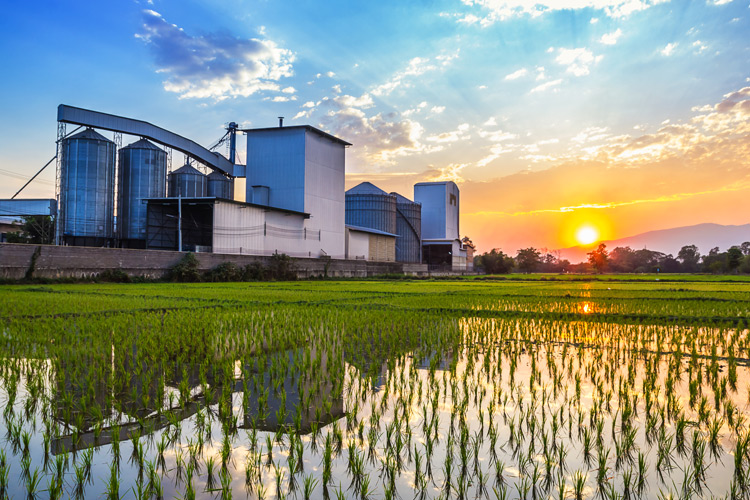Let’s talk money. Maybe we should be more specific than a generic statement like that. Let’s talk about how to get more money in your pocket. There, I thought that would get your attention. In the farming business, and in any serious business, we are always chasing the alluring dollar. How we limit our expenses and increase profit keeps us up at night. Let me introduce you to your new sleeping pill. The purpose of this article is to paint the picture of how owning your own rice mill can not only pay for itself, but diversify your business, increase your branding efforts, and put additional money in your pocket.
We are going to use an example of a rice farmer in Arkansas producing 500 acres of rice. According to the Economic Research Service of the USDA, the total average gross value of rice production in Arkansas per acre for 2014 was $1,104. An acre of rice in Arkansas produced 77 hundred weights (7,700 lbs). A 500 acre crop would yield 3,850,000 lbs of paddy. Divide $1,104 gross value by 7,700 lbs and you should have been paid $.14 per pound of paddy rice ($6.30/bushel). The average operating and overhead costs per acre in 2014 was $907.57. That leaves a profit of $196.61 per acre. Multiply that profit by 500 acres and you are sitting at $98,305 annually. Please re-read and double check these numbers to suit your situation before moving forward.
In local supermarkets, you can find 1 lb of packaged white rice selling commonly for $1.00/bag. Some varieties bring quite a bit more, but let’s use that figure for ease of understanding. You were paid $.14 per pound but the store is selling it at $1.00 per pound. What happened to the other $.86? The rice mill that bought your paddy took a little bit. The marketing companies that sold it to took a little bit. The company that packaged and labeled it took a little bit. And finally, the grocery store took a little bit. If that wasn’t frustrating enough, they took the high quality rice that you worked so hard to produce and blended it with everyone else’s lower grade to fill that bag in the supermarket. Where’s the love in that?
What if someone were to show you a way to make more money, brand your own farm’s rice for your local market, and preserve the identity of your rice? Interested? Keep reading.
The ZX-6 rice mill of the Zaccaria Rice Milling line is considered to be a compact mill for small farm operations. It has a capacity of 1,100 lbs/hour paddy input. If you were to run that for 40 hours per week at 50 weeks per year, you would accomplish milling only 2,200,000 pounds of paddy. You would still have 1,650,000 pounds of paddy to either hold onto for the next year or sell to the rice mills for diversification standpoint. Selling that amount for $.14/lb allows you to keep $42,130 in your pocket (1,650,000 lbs ÷ 7,700 lbs/acre x $196.61 profit per acre). Now that you have some money, let’s keep moving. You have diversified your risk of going into the milling business full steam – nice job!
Back over to the 2,200,000 pounds of paddy. In order to make white rice, you have to remove the husk and the bran layer from the white rice kernel. Doing that will remove roughly 30-35% of the weight. For conservative purposes, let’s say that you are left with 65% of the original weight, or 1,430,000 pounds. Within the milling process, you are going to have broken kernels that cannot be included in your packaged head rice. Let’s say that’s another 5% of the weight, leaving you with 1,338,480 (Remember, though, Number 2 USDA grade rice, which is typical for supermarket trade, contains up to 7% brokens). Now, I’m not going to tell you the price of the ZX-6 rice mill just yet. If you were able to take 1,320,000 pounds of rice, package it, and sell it for $1/bag (which is the current going rate), you would now have made $1,320,000 on top of the $42,130 that you received from the paddy rice you sold to the mill. Read this paragraph over until you get the full scope of that last statement. Sale prices of edible rice products are not directly tied to weather or crop yield. Consumers have a perception of value placed on fresh, healthy food products but the demand remains the same or increases in specialty rice products like identity preserved organic brown rice, aromatics, etc.
The ZX-6 standard rice mill comes with a couple of different pieces.
- An elevator to feed the pre-cleaner
- A pre-cleaner which removes waste from your paddy prior to entering the mill.
- An elevator to feed the ZX-6 mill
- The mill itself which husks the rice kernel and removes the bran
- A husk cyclone to collect the husks
- An elevator to feed the length separator
- An indented cylinder which separates whole kernels from brokens by length
- An elevator to handle head rice and brokens for packaging.
- Necessary piping and spouting
There are other options that you can include with the mill including day bins, color sorters, metal detectors, enrichment machines, packaging lines, motor controls, and electronic weighers and baggers. Those are all optional, but items you might want to consider in your production mill.
The cost of the ZX-6 rice milling machine is $25,000 FOB factory. Once you add a packaging line, color sorter, bagging equipment, and all optional equipment, you would have spent a total of roughly $300,000. Again, all of that equipment is optional, but that’s still less than the cost of a new combine.
Let’s recap! You’ve diversified your crop, you’ve introduced yourself into the milling business, you are private labeling your identity preserved rice and are a hero in your local market, you’ve only spent an additional $300,000 but you’ve increased your revenue from $98,305 to $1,362,130. (Don’t also ignore the profit potential for also selling by-products; brokens, husk, and bran which organically happens during the milling process). If you are still queasy about coming up with $300,000, we have partnered with a financing company that specializes in underwriting loans and leases for manufacturing equipment. Our guess, though, is that you will have it paid off in no time.
Now, go to sleep while counting dollar signs jumping over the fence and call us in the morning.

